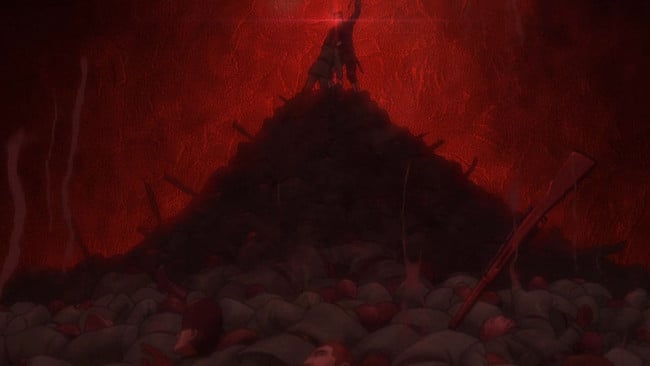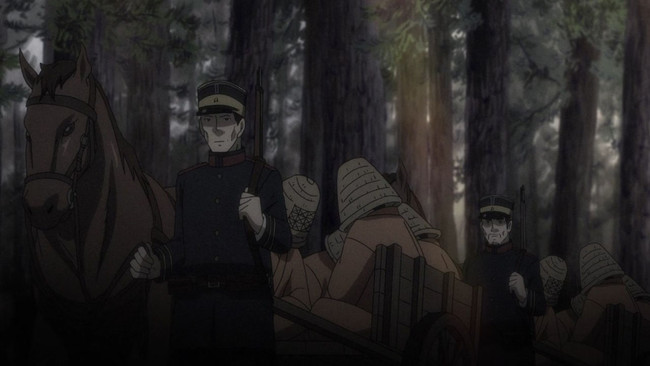The True History Behind Golden Kamuy
by Marco Oliveros,Golden Kamuy is a story more heavily informed by its historical context than most. Sure, it has its gratuitous violence and gore, peculiarly dumb reaction faces, lengthy hunting and cooking sequences, and body shapes inspired by JoJo's Bizarre Adventure. However, the glue that binds everything together into a compelling tale is Golden Kamuy's well-written characters, whose drama is informed by their pasts. These characters are products of the eras that they lived in and fought through.
While the audience isn't required to have an advanced knowledge of modern history to appreciate Golden Kamuy, acquiring some understanding of Japan just around the turn of the 20th century may illuminates these characters' motivations further. Here's my breakdown of some relevant aspects of Japanese history that may help you understand Sugimoto and Asirpa's world.

Considering each other rivals in territorial expansion through Far East Asia, war broke out between the Russian Empire and the Empire of Japan a little after the turn of the 20th century. The Russo-Japanese War, which lasted between 1904 and 1905, was a conflagration fought across two stages: land and sea.
On the seas, the Japanese navy scored a spectacular victory against their Russian counterparts. The Russian Empire ordered the bulk of its Atlantic fleet to the Asian Far East, traveling all the way the over the tip of Africa to reach the Sea of Japan. These Russian ships were then unceremoniously annihilated by their Japanese opponents at the Battle of Tsushima. This loss, combined with the earlier destruction of its remaining Pacific Fleet Power in Port Arthur, put the Russian navy out of commission. The Japanese success in this battle cemented victory in their war with the Russians, while demonstrating to skeptical Western observers that Japan was a force to be reckoned with.

Over land, the Japanese army's successes were fewer and far bloodier. The technology and tactics of modern warfare that heralded the carnage of The Great War in the Battle of Cold Harbor during the American Civil War would resurface again before World War I in the Japanese Siege of Port Arthur. Machine guns, hand grenades, trenches, and artillery bombardments combined to turn the battlefield into a human meatgrinder. The defending Russians would lose over 30,000 soldiers in the year-plus campaign, and the Japanese would shed nearly twice that number in manpower. The Battle of 203 Hill alone cost the Japanese over 8,000 men, ravaging the ranks of the Japanese army's 7th Division.
The Imperial Japanese victories in the Tsushima Straits, Port Arthur, and others, costly or otherwise, convinced the Russian Empire to seek peace. With American President Theodore Roosevelt presiding as a broker, these peace talks resulted in the Treaty of Portsmouth.

Even with its victories, the Japanese were stretched thin in capital and soldiers by the end of the war, and continued fighting would drain the empire of ever more precious treasure and manpower. Every major land battle that the Japanese fought until then had been costly, so every major win on land was pyrrhic. The Treaty of Portsmouth that ended the Russo-Japanese War regarded Japan as the winner, granting them direct territorial concessions from the Russians and tacit respect for the Empire of Japan's influence and control in East Asia.
However, those concessions did not include remunerations from the Russians for the coin spent and lives lost by the Japanese. The lack of reparations for the Japanese people's sacrifices left many citizens and many Russo-Japanese veterans resentful. From this outrage, Golden Kamuy introduces soldiers of the Japanese army's 7th Division, who are resentful survivors of the fractured Hokkaido infantry group. Now seething with resentment against the Japanese government for leaving their sparse survivors traumatized, they are plotting a secessionist movement from the rest of Japan using Ainu gold as capital.

Now let's shift backward in time a bit. The Bakumatsu refers to the period between 1853 and 1867, the waning years of the Tokugawa era. During this period, rebels fighting in the name of the Japanese emperor faced off against loyalists to the Tokugawa shogunate. The shogunate had ostensibly been administrating Japan in the Emperor's name for centuries, but in reality, the position was reduced to a ceremonial head of state under the Tokugawa clan, with Tokugawa bannermen looking on from a taller castle in Kyoto to make sure that the Emperor would always know his place in his shorter palace. The rebels were supposedly fighting to restore the Emperor's traditional powers, but for many partisans, their most pressing priority was to tear down the old feudal order and establish a modern centralized state that could resist Western invasion. (Oddly enough, these same rebels used Western-imported military technology to achieve their ends.)
Ever since the forcible opening of Japanese trading ports by American coal-coated gunboats in 1853, the Tokugawa were coerced into signing trading and extradition agreements with the other Western powers. These unequal treaties included such provisions as forbidding the Japanese from raising anti-duty tariffs against the Western powers and prohibiting them from prosecuting Westerners who violated their laws. Due to centuries of diplomatic and trading isolation from most of the world, Japan was technologically under-equipped to match the West's modernized arsenals. However prudent these concessions may have seemed at the time, the unequal treaties hurt the Japanese economy and further wounded Japanese pride. When the Tokugawa capitulated to Western demands, civil war was ignited.

In the Bakumatsu conflict between the Imperial rebels and the Tokugawa loyalists, a group of samurai warriors called the Shinsengumi were assembled to serve as commanders and guardians on the battlefield and the capital alike. Despite their legendary reputation, the Shinsengumi's shogunate patrons were overthrown in 1867, which kicked off the Meiji era. Some surviving Shinsengumi were re-integrated into the new regime, while others were executed or imprisoned, and still others retired or went into hiding, as samurai were fully phased out as a privileged social class. All this context finally brings us back around to Golden Kamuy. Two old Shinsengumi souls, still vibrant with fighting spirit and fiery resentment, are introduced in the story as their own gold-seeking faction. Brandishing modern Western guns alongside their traditional Japanese swords, they too have plans to establish an independent state in Hokkaido, with blood and treasure as their down payment.
Indeed, Imperial partisans fought against the Tokugawa for a while, after they had capitulated to the West. Oddly, the Imperial regime decided the best way to renegotiate the unequal Bakumatsu-era treaties was to convince Western powers that Japan was their equal. Recognizing the West's dominance in global affairs, the Meiji government continued to import Western technologies, invite Western advisers, and even adopt Western culture to in efforts to be judged as sufficiently modernized. However, it was only after Japan's victory in the Russo-Japanese War that Western powers became willing to renegotiate in the hopes of getting on Japan's good side.

Formerly known as Ezo, Hokkaido wasn't fully integrated into the rest of Japan until the advent of modernity brought on by the Meiji Era. The Tokugawa shogunate were largely uninterested in developing the island, due to the exorbitant costs and limited returns involved. Hokkaido bore an even harsher and colder climate than the northernmost parts of mainland Honshu. Agriculture was a major source of wealth in Tokugawa Japan, with rice acting as its own official unit of currency. However, rice agriculture was harder to sustain in Hokkaido without more thorough tending, and settlements struggled to grow in Hokkaido because of shorter growing seasons. Ultimately, the shogunate left the protection of Japan's northernmost borders and the privilege to develop Hokkaido to the Matsumae daimyo. Daimyo during the Tokugawa era, and especially northern daimyo like the Matsumae who administered less fertile lands, often found themselves strapped for cash after fulfilling their tributary duties.
Some daimyo-sponsored missions and enterprising Japanese citizens established a few settlements in Hokkaido. Commerce in the area mainly revolved around trading furs with the indigenous Ainu, with Japanese traders from the south and Russian traders from the northwest competing for business. Unsurprisingly, the Ainu knew the land far better than Hokkaido's competing settlers. They were the land's undisputed masters in fishing, trapping, hunting, and surviving, so the Ainu played the two foreign groups off each other for commercial and political benefit at times.

However, the Ainu were ultimately victims of these two groups' political and commercial machinations. Hokkaido became an increasingly contentious arena between the Japanese and Russians for dominance in the lead-up to the Bakumatsu era. The Russians attempted to make alliances with Ainu villages, and the Japanese forced assimilation initiatives on the Ainu people to erase their culture. In response to Japanese oppression, the Ainu staged unsuccessful rebellions against the Matsumae.
Eventually, the Tokugawa shogun moved to exert direct control over Hokkaido for its importance to national security against foreign influence (Russian especially). However, large-scale settlement of Hokkaido could only be achieved with the resources that came from the Imperial regime, after the Meiji Restoration. In addition to national security, the Meiji government sought to bolster the trading, agricultural, and mineral production of the island. Thanks in part to those efforts, the Hokkaido port of Hakodate became an important trading hub. In spite of the harsh climate, Hokkaido became a major producer of agricultural products with the help of Western advisers. Its mining operations (and gold deposits in particular) serve as the central conflict and plot impetus for Golden Kamuy. The Ainu would continue to be affected by Japanese assimilation efforts, and some were even enlisted into the Japanese army during the Russo-Japanese War.
Taken all together, this history forms a solid bedrock for understanding Sugimoto's history as a soldier, Asirpa's perspective as an indigenous Ainu girl, and the various other characters and forces whose motivations are based not only in the changes brought about by the war, but the many altercations that led to this point in the 20th century. It will be interesting to see how this context illuminates their quest for the golden treasure going forward.
Social Scientist & History Buff. Dabbles in Creative Writing & Anime Criticism. Consider following him at @ZeroReq011
discuss this in the forum (4 posts) |
this article has been modified since it was originally posted; see change history